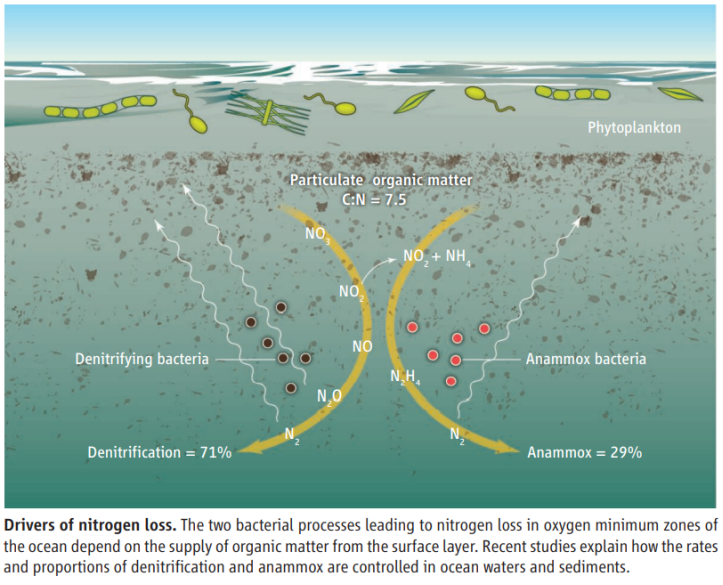How nitrogen is lost
氮是生物地球化学循环过程中的重要元素,也是海洋中的生产力的主要限制因子,因此了解氮收支关键过程具有重大意义。在全球尺度范围内,人们往往认为氮固定(输入)和氮流失(输出)的速率大致相等,但实际上现有数据表明海洋中氮的源汇存在不平衡。本文将简要介绍氮在海洋中的流失过程及其环境调控。
Nitrogen is an important element in biogeochemical cycling processes and a major limiting factor for productivity in the oceans, making it of great importance to understand the key processes of nitrogen input and output. On a global scale, the rates of nitrogen fixation (input) and nitrogen loss (output) are believed to be roughly equal. Both rates are, however, very uncertain. This paper will briefly describe the process of nitrogen loss in the ocean and its environmental regulation.
氮流失主要通过两个过程:反硝化和厌氧氨氧化,这两个过程是依赖于不同的生物和代谢途径。反硝化是通过还原反应将NO3-依次还原为N2,并以强温室气体氧化亚氮(N2O)为中间产物;而厌氧氨氧化将铵(NH4+)和亚硝酸盐(NO2-)结合直接生成N2。大多数反硝化菌从浮游植物产生的有机物中获得生长所需的碳(C),因此反硝化是异养过程;而厌氧氨氧化细菌自身就能将CO2固定为生物量,是自养过程。大多数反硝化菌消耗和降解有机物,释放溶解的无机氮(包括NH4+和 NO2-),而厌氧氨氧化菌需要NH4+和 NO2-作为底物,NH4和NO2-来自于其他微生物介导的有机物分解(见图)。因此,反硝化过程产生的NH4+和 NO2-可以为厌氧氨氧化细菌提供底物。
Two main processes are responsible for nitrogen loss: denitrification and anaerobic ammonium oxidation (anammox). These processes rely on fundamentally different organisms and metabolic pathways. Denitrification is the sequential reduction of nitrate (NO3-) to dinitrogen gas (N2) via oxidized intermediates, whereas anammox combines ammonium (NH4+) and nitrite (NO2) to yield N2. Most denitrifying organisms obtain their carbon (C) for growth from organic matter produced by phytoplankton, whereas anammox bacteria fix their own CO2 into biomass. Most denitrifiers consume and degrade organic matter, releasing dissolved inorganic nitrogen (including NH4+ and NO2-). Anammox bacteria require a source of NH4+ and NO2-, derived from the breakdown of organic matter by other microbes (see the figure). Thus, NH4+ and NO2-produced by the denitrification process can provide substrate for anaerobic ammonia oxidizing bacteria.

反硝化和厌氧氨氧化发生在缺氧水体和沉积物等还原性环境中,两者往往存在时间或空间上的耦合,但反硝化通常主导氮移除。因此,两个氮移除路径的量级及其相对重要性在一定程度上直接调控了地球系统的氮汇大小和温室气体N2O源汇。然而有报道发现在氧浓度极低的开放海洋区域[氧最低区(OMZs)]只有厌氧氨氧化反应存在,同时在全球海洋范围内的OMZs环境中反硝化和厌氧氨氧化反应几乎很少同时存在。这表明,野外环境中的氮移除途径可能受到不同环境因素的调控。目前有假说来解释某些地区为何明显缺乏反硝化作用:反硝化作用可以发生在OMZs中,但由于有机质的间歇性供应,反硝化作用在空间和时间上的分布是零散的。在这种情况下,反硝化在一定范围内呈现间断性与动态变化,而厌氧氨氧化是缓慢(大多数海洋细菌和其捕食者的传代时间最多为几小时到几天, 但厌氧氨氧化细菌传代时间最短接近2周)、稳定和同步的,但最终依赖于反硝化来提供溶解无机氮(DIN)。
Denitrification and anaerobic ammonium oxidation occur in reducing environments such as anoxic waters and sediments, and the two are often coupled in time or space while denitrification usually dominates nitrogen removal. Thus, the magnitude of the two nitrogen removal pathways and their relative importance directly regulate, to some extent, the size of the Earth system’s nitrogen sink and the source sink of the greenhouse gas N2O. However, it has been reported that only anaerobic ammonium oxidation reactions are present in open ocean regions with very low oxygen concentrations [oxygen minimum zones (OMZs)], while denitrification and anaerobic ammonium oxidation reactions are almost rarely present simultaneously in OMZs environments on a global ocean scale. This suggests that nitrogen removal pathways in the field may be regulated by different environmental factors. There are hypotheses explaining the apparent lack of denitrification in certain areas: denitrification can occur in OMZs, but its distribution is spatially and temporally fragmented due to intermittent availability of organic matter. In this case, denitrification is intermittent and dynamic over a range of time, whereas anaerobic ammonium oxidation is slow (most marine bacteria and their predators have a generation time of a few hours to a few days at most, but anaerobic ammonium oxidizing bacteria have a minimum generation time close to 2 weeks), stable and synchronous, but ultimately dependent on denitrification for the supply of dissolved inorganic nitrogen (DIN).
最近在南美洲海岸(东热带南太平洋OMZ)的一个断面中,Dalsgaard等人同时检测到厌氧氨氧化和反硝化。厌氧氨氧化在几乎每个站点都以较低的速率发生,而反硝化则较少被检测到,但却在少数站点出现了很高的速率。当对他们的数据集进行平均化时,来自反硝化和厌氧氨氧化的氮损失比例为72:28,接近预期的比例(反硝化和厌氧氨氧化以71:29的比例将有机物完全分解和矿化并形成CO2和N2气体。任何其他比例都需要从其他来源提供氮或碳),但与之前在同一地区报道的一些测量结果中厌氧氨氧化的优势地位相差很远。
Recently, in a transect along the coast of South America (the eastern tropical South Pacific OMZ), Dalsgaard et al. detected both anammox and denitrification. Anammox occurred at almost every station at low rates, whereas denitrification was less commonly detected but occurred at very high rates at a few stations. When averaged over their data set, the ratio of nitrogen loss as N2 from denitrification and anammox was 72:28, close to the expected ratio (Complete decomposition and mineralization of this material to form CO2 and N2 gases can occur by denitrification and anammox in the ratio of 71:29. Any other ratio requires the supply of nitrogen or carbon from an additional source) and far from the dominance by anammox previously reported from the same region on the basis of a few measurements.
与此同时,室内调控实验发现氮的总体损失率取决于加入有机物质的量,反硝化:厌氧氨氧化的速率比例取决于可利用底物的碳氮比(C:N)。无论是在沉积物还是在OMZ水域中,与海洋平均C:N(~7.5)接近的天然有机底物导致的反硝化:厌氧氨氧化比为70:30,这几乎与预测的比率(71:29)完全一致。添加氨基酸或添加蔗糖与铵的培养基,它们对应的厌氧氨氧化比例分别为较高和较低,趋势与这些底物的C:N差异一致。
Independently, work in my lab found that the overall loss rate depends on the amount of organic matter added and that the ratio of denitrification:anammox depends on the carbon to nitrogen ratio (C:N) of the available substrate. In both sediments and OMZ waters, natural organic material with a C:N ratio very close to the ocean average (~7.5) resulted in a denitrification:anammox ratio of 70:30—almost exactly the predicted ratio. Incubations augmented with amino acids or sucrose plus ammonium had higher and lower anammox proportions, respectively, in line with the C:N ratios of these substrates.
在OMZ环境中,DIN只能来自于水体中有机物的降解(见图),氮的总损失率和反硝化和厌氧氨氧化的相对贡献必将受到有机物供应的限制。Dalsgaard等通过大量现场观测表明:反硝化和厌氧氨氧化存在时空异质性,且解释了有机物质供给成分方面的一系列差异。但有些反硝化菌可通过氧化还原态硫化合物来固定CO2以此获得能量。通常,这些硫化合物被认为只在沉积物中是重要的,但最近关于硫化物氧化和自养硫氧化基因的活性表达的研究证据表明,在OMZs中,一个隐藏的硫循环与反硝化有关。因此,有机物可能不是这些地区反硝化速率的唯一控制因素。
In the OMZ, where DIN can only come from the degradation of organic matter in the water column (see the figure), the total rate of nitrogen loss and the relative contributions of denitrification and anammox must be constrained by the supply of organic matter. The extensive field measurements by Dalsgaard et al. show that denitrification and anammox are differently distributed in time and space. The experiments provide an explanation for those differences in terms of the composition of the episodic organic matter supply. Some denitrifiers obtain the energy for CO2 fixation from the oxidation of reduced sulfur compounds. Usually, these organisms are considered to be important only in sediments, but recent evidence of sulfide oxidation and of active expression of autotrophic sulfur oxidation genes suggest that a cryptic sulfur cycle is linked to denitrification in the OMZs. Organic matter thus may not be the only control on denitrification rates in these regions
反硝化和厌氧氨氧化共同作用于OMZs和海洋沉积物,有效地消耗了从表层水中下沉的有机物,并解释了海洋氮损失。氮损失率对有机质供应的依赖表明海洋氮碳循环紧密耦合,并控制着上层水体的营养水平。
Denitrification and anammox together, occurring in the OMZs and ocean sediments, effectively consume the organic material sinking out of the surface waters and account for all the oceanic nitrogen loss. The dependence of nitrogen loss rates on organic matter supply implies a tightly coupled oceanic nitrogen cycle, which controls the fertility of surface waters.
参考文献:https://pubmed.ncbi.nlm.nih.gov/23888027/
Reference: https://pubmed.ncbi.nlm.nih.gov/23888027/
投稿者:符春蔚
审核导师:谭萼辉
 公众号
公众号